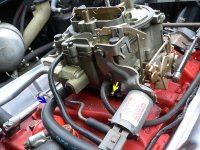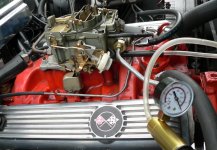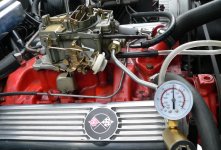antijam
CCCUK Member
When I first bought my small block '71 it was fitted with a non-original quadrajet and had severe bogging and popping and banging on the overrun. after much fruitless fiddling I replaced the carb with a correct, professionally rebuilt quad and after upping the jets three sizes above standard to compensate for the better breathing afforded by headers and a free flow exhaust, bogging and banging were cured. It ran well like this for some years although every time the plugs were checked they were pretty sooty suggesting the car was running rich. Anyway, having recently corrected an annoying and persistent vacuum leak I wondered if I could come down a jet size to compensate. Accordingly I replaced the jets with one size smaller and the car ran fine except that the popping and banging on the overrun had returned! At this point it dawned on me that since the new carb ran fine on fitting, other than the jet upsizing I had made no adjustments to the other settings. Since the popping and banging were effectively occurring at idle, had I neglected to check, and if necessary adjust, the hot idle mixture settings?
OK, better late than never, I give it a go. The quad has two mixture screws in the base of the body - one is arrowed yellow in this pic.....

....and they need to be adjusted to achieve maximum manifold vacuum at hot idle. So after warming the engine up until the choke is fully off I remove the PCV tube (arrowed blue) connection at the carb and attach my vacuum gauge instead.

I restart the engine and carefully tweak the mixture adjusters one at a time to achieve maximum vacuum; this stabilises at just over 15 inches of Hg.

I noticed that both adjusters were several turns off the optimum setting.This done I adjust the idle to a stable minimum which turns out to be 500 rpm. The car is a manual so this idle is fine; an auto would probably need around 700 to 800 rpm.
With the PCV line reconnected I restart the car and we're off for a test drive. Popping and banging have disappeared and the car seems to be pulling better than ever! I fill the tank and put in around 150 miles over the next few days before pulling and checking the plugs. All are now the textbook light tan colour indicating proper combustion. If I'd done what I should have done when originally fitting the carb the problem would have been sorted correctly years earlier. Oh well, even at 82 I'm never too old to learn.
Incidentally after the few days running I decided to check my fuel consumption. I don't normally do this on any classic car since good fuel consumption is never one of the criteria for purchase. Anyway, consumption turns out to be a shade over 13 mpg. Not very impressive but I have to admit I do tend to give the secondaries a fair amount of action - primarily for the noise! Hey ho - it's only money.....
Hey ho - it's only money.....
OK, better late than never, I give it a go. The quad has two mixture screws in the base of the body - one is arrowed yellow in this pic.....

....and they need to be adjusted to achieve maximum manifold vacuum at hot idle. So after warming the engine up until the choke is fully off I remove the PCV tube (arrowed blue) connection at the carb and attach my vacuum gauge instead.

I restart the engine and carefully tweak the mixture adjusters one at a time to achieve maximum vacuum; this stabilises at just over 15 inches of Hg.

I noticed that both adjusters were several turns off the optimum setting.This done I adjust the idle to a stable minimum which turns out to be 500 rpm. The car is a manual so this idle is fine; an auto would probably need around 700 to 800 rpm.
With the PCV line reconnected I restart the car and we're off for a test drive. Popping and banging have disappeared and the car seems to be pulling better than ever! I fill the tank and put in around 150 miles over the next few days before pulling and checking the plugs. All are now the textbook light tan colour indicating proper combustion. If I'd done what I should have done when originally fitting the carb the problem would have been sorted correctly years earlier. Oh well, even at 82 I'm never too old to learn.
Incidentally after the few days running I decided to check my fuel consumption. I don't normally do this on any classic car since good fuel consumption is never one of the criteria for purchase. Anyway, consumption turns out to be a shade over 13 mpg. Not very impressive but I have to admit I do tend to give the secondaries a fair amount of action - primarily for the noise!



